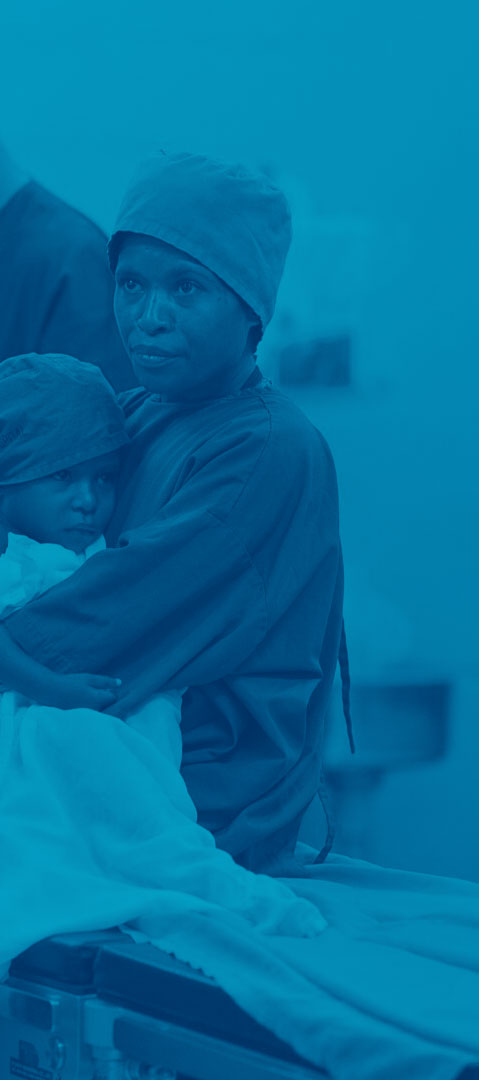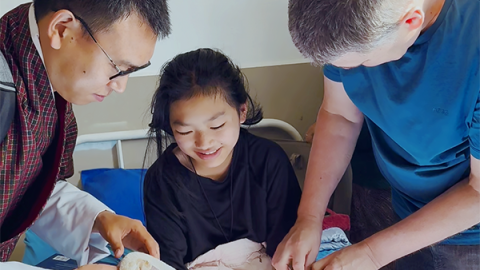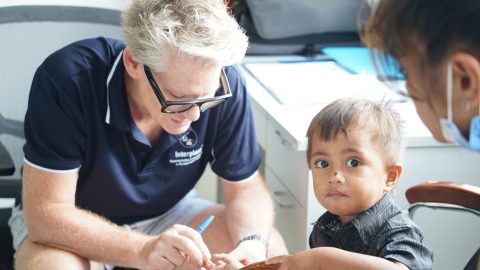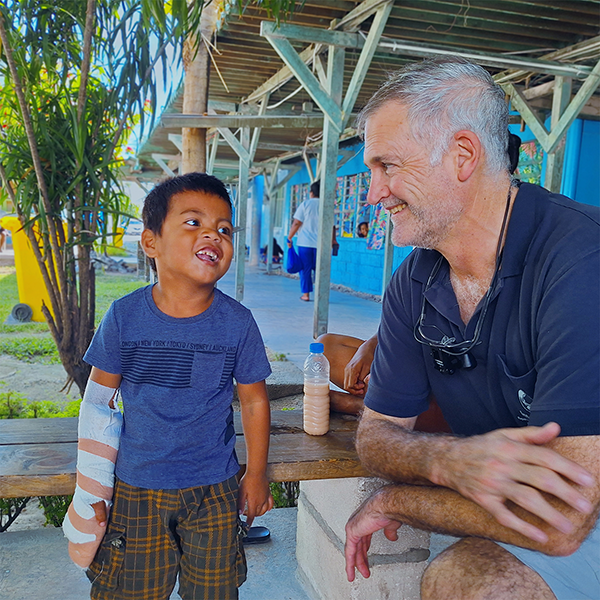
Beia with Interplast volunteer Dr Mark Strahan, after successful surgery to address a burn on his arm. Not slowed down for a moment, he was back trying to make his mother laugh the morning after his surgery.
Interplast has been sending programs to Kiribati since 1986. In June, our volunteer team returned for the first time since 2019 to provide life-changing surgery to patients and learning opportunities to local staff.
Overcoming challenges before arrival
Before the program begins, our local partners in Kiribati prepare a list of patients who would benefit from consultations with the Interplast team. Director of Health Services, Dr Tekeua Uriam Kabiri, and surgeon, Dr Uriam Salomia, pour through potential patients and arrange for them to be at Tungaru Central Hospital to meet the team.
However, the first thing to arrive in Kiribati is the essential medical equipment and supplies needed for treatment.
Did you know that the cost of transporting the essential equipment our team need is one of the highest costs of providing life-changing care? Many of our partner countries have limited supplied and rely on Interplast to provide specialist materials. Unfortunately, the COVID-19 pandemic drastically increased shipping costs, which has significantly increased the burden on our programs.
Getting all personnel and equipment to arrive in-country is often a feat in itself!
Delivering outstanding care
No hour is wasted. The week was made-up of long operating days, lectures, demonstrations and evenings with the Australian High Commission and Rotary Club of Tarawa.
All the hard work pays off in a big way. Together, our team delivered:
- 20 surgical procedures
- 15 allied health treatments
- 111 training opportunities.
Patients were of all ages: 18 adults and 15 children. One of these children is Roten.
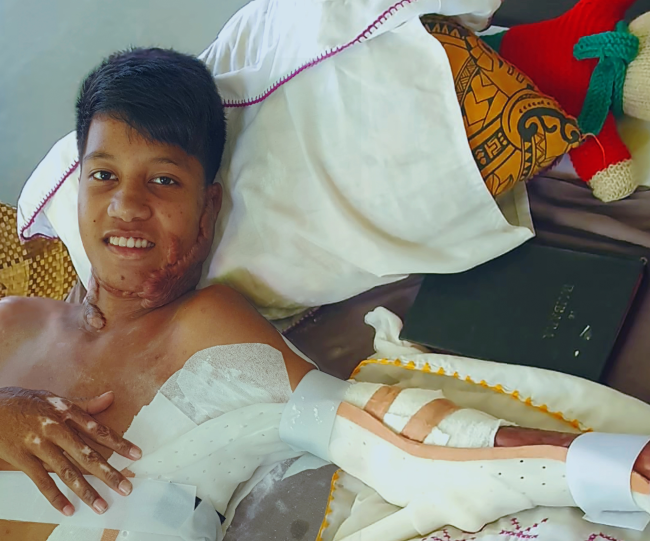
Meet Roten
Three years ago, Roten sustained severe burns when a flammable liquid canister exploded as he was singeing hairs off meat for cooking. The explosion devastated his upper body, causing thick burn scar contractures and dislocating a joint in his left hand, limiting his movement.
“As he walks into our clinic, our team is already planning his surgery, his potential outcome, our limitations. Each of us have an important role to ensure Roten is able to live the life of every 15-year-old child,” Interplast volunteer and nurse, Joanne Oxbrow, wrote in her report.
For the best outcome, Roten needed the expertise of multiple different disciplines.
Dr James Savundra, Dr Mark Strahan, Dr Sam Teeta, and Dr Uriam Salomia operated on Roten, with Dr. Lamour Hansell and Dr. Teraiman Kabong providing anaesthesia. Together, they released the burn scar contracture on Roten’s armpit and elbow, and closed them with a split skin graft and flap.
Meanwhile, physiotherapist Carolyn fabricated a comfortable airplane splint for Roten, to keep his arm at a 90-degree angle. This splint will carefully stretch the scar tissue as Roten heals from surgery, so he will be able to move after he heals.
Carolyn also worked with the local physiotherapy team to plan Roten’s long-term rehabilitation, including pulley exercises, stretches and gentle sports activities, to give him the best chance at regaining as much mobility as possible.
“When I visit Rotan on our last day in Kiribati, his eyes are bright, and he wears a cheeky grin. The type of smile all 15-year-old children should display… He is comfortable and excited about the progress he had made towards recovery with a little help from our team,” Joanne concluded.
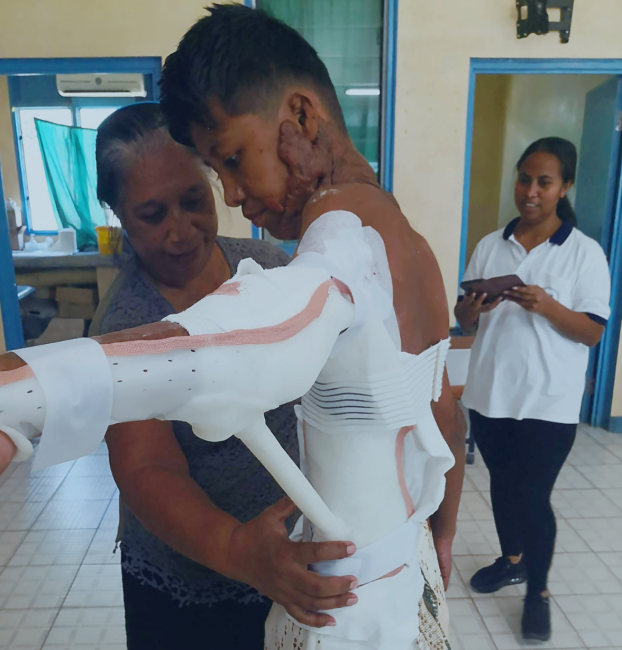
Great turnout for pain management training
In a culture where pain is not often expressed voluntarily, recognising and addressing pain as health practitioners can be even more challenging.
Throughout the week, Dr Tania Morris, a pain management educator, delivered a mix of formal and on-the-job pain management training to clinicians at the Tungaru Central Hospital. The training saw outstanding local engagement, with 95 participants from across the island taking part.
Dr Morris covered standardised approaches to pain management, but also opened the floor for discussions on the specific challenges and issues local staff had been facing. She also aligned sessions with current patient treatment, giving staff on ward the ability to put their learning into immediate practice.
The training cohort appreciated learning from local, relevant cases.
“As I gain more understanding on pain management, and more knowledge on splinting and assessment in more advanced protocols shared by Carolyn, these new skills will help in many ways to strengthen our treatments and reassure more patients,” Tamwaria, Physiotherapist at Tungaru Central Hospital.
Another participant happily reported that “the presentation is clear and fun, very enjoyable and I don’t get sleepy during the presentation.” Which is also great feedback!
By the end, many reported an increase in awareness of pain management strategies and confidence in recognising and addressing their patients’ pain.

Dr Morris presents a session on assessing pain severity and how patients may show pain.
Acknowledgements
Interplast would like to acknowledge our incredible volunteers for their hard work on this program. Our gratitude is extended to:
- Dr Mark Strahan
- Dr James Savundra
- Dr Lamour Hansell
- Dr Tania Morris
- Carolyn Asman
- Joanne Oxbrow.
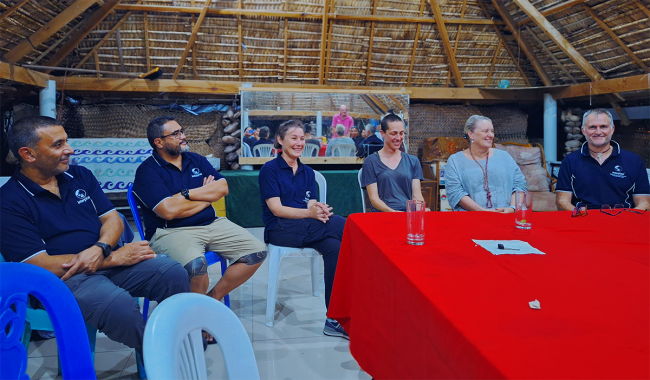
Left to right: Dr James Savundra, Dr Lamour Hansell, Joanne Oxbrow, Carolyn Asman, Dr Tania Morris, Dr Mark Strahan.
We also acknowledge the generous funders who made this program possible. Thank you to the Rotary Clubs of Districts 9920 and District 9675, the Rotary Clubs of West Wollongong, Phillip Island & San Remo, and Launceston West, the Australian and New Zealand College of Anaesthetists and other partners.
Thank you also to The Pacific Community (SPC) for their support in enabling Samoan anaesthetist Dr Lamour Hansell to join the team at short notice, and supporting i-Kiribati anaesthetic trainee, Dr Teraiman Kabong, to travel from Fiji where she is currently training, to work alongside the team.
Additionally, we thank personnel of the Tungaru Central Hospital and our i-Kiribati hosts for their hospitality and engagement.
